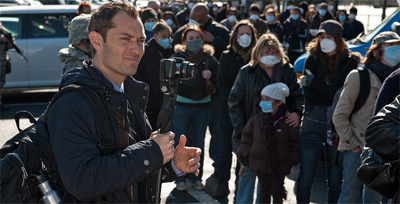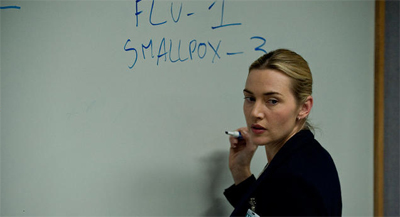It’s somewhat ironic that the biggest fault with Contagion is that it’s not nearly clinical enough. Soderbergh’s exploration of the impact of a mass pandemic actually works best when the director pulls back to give us a high-level overview of a society collapsing, the individual lives reduced – appropriately enough – to microscopic cells in a larger organism in what might be its death throes. It’s these sequences and shots that are brilliantly effective, demonstrating the systemic and group dynamics that enable and facilitate the spread of a deadly bird flu variant, while the more intimate moments feel awkward and shoehorned in, never afforded enough space to develop character or plot lines. Still, if you pull back and look at the big picture, Soderbergh’s latest effort is an engaging ambitious disaster movie.
Contagion might be the best horror film I’ve seen in quite some time. It might seem like a strange classification, but it’s one that fits. Soderbergh does use some techniques one recognises in horror to great effect, like close-ups on mouths and skin and sweat to create a sense of revulsion or lingering shots on handheld objects to create a sense of foreboding and inevitable dread. However, beyond the superficial similarities, you could argue that the film documents the type of struggle against an unknowable and inconceivable foe that we regularly see in horror films. Sure, Soderbergh doesn’t populate the film with jump cuts or “it’s behind you!” moments, because that would be silly – instead it’s the shocking speed at which events unfold and the way that people are powerless to stop it. The mutated bird flu – “the wrong pig met the wrong bat” – isn’t something that can be vanquished or confronted, it’s an abstract concept.
Watching the news coverage around swine flu or other potential epidemics, one could be forgiven for staying up at night in abject terror about the possibility of an anonymous infectious disease striking us down with little or no warning, a random genetic fluke that could dismantle the entire apparatus of human civilisation. “The average person touches their face 3-5 times every waking minute,” we’re told. “In between, we’re touching doorknobs, water fountains, and each other.” That’s a terrifying thought, right there, and it’s one that can’t be warded away like a man with a knife or even a vampire. And, like any good horror film, Soderbergh layers on the social commentary – with the characters defined by their response to this external threat.
Between this and Melancholia, it seems that 2011 was the year of the unconventional disaster film. Perhaps it’s appropriate that Roland Emmerich backed away from the genre to direct Anonymous. Contagion opens with a wonderfully effective sequence, turning the audience expectations on their heads. We’re introduced to a relatively small nuclear family, where the father is the only member not afflicted by the disease. It initially seems like it might be because he is the only person or thing in his wife’s life that she doesn’t touch, but it’s later explained that he has a natural immunity. In any other film about a natural catastrophe – an alien invasion, an earthquake, a deadly virus, a nuclear explosion – this father would be tasked with protecting his family from harm, and thus proving himself a “real” man (because he starts the movie unemployed, like any number of fictional deadbeat fathers who need the end of the world to prove their worth). Instead, the movie brutally kills his wife and his young son within the first twenty minutes, the first sign that things are not going to play out as we expect, deconstructing the idea of Spielbergian patriarch as the lynchpin of the family unit.
The problem is that this should really be the last we see of these characters. Soderbergh has made his point. This isn’t The Day After Tomorrow or 2012. It’s somehow bigger than those two combined CGI-fests. We’re not watching a bunch of Hollywood stars fighting for the survival of a child actor we’ll never see again. Instead, we’re watching a global community that is under full-scale assault. However, after that powerful opening, the movie falls back on the cliché of a father defending his brood from outside assault, which is a shame – I think the movie would have worked much better if the last time we saw the father was isolated in a hospital ward, confronted with some pretty devastating home truths. The problem is that we don’t simply have time to care about the individual players in the drama, so they just end up like cardboard cutouts adherring to a formula.
There are other dead-end plots as well, which is a shame when the story is this expansive and the cast is so vast. In generally, it’s the stories that spend the most amount of time “on the ground” that tend to drag, with little chance to define themselves in the context of a film that is so busy dealing with wider dilemmas. There’s a strange little subplot involving a World Health Organisation official that takes a strange turn, disappears and then reappears almost at random. There’s not enough material there to give these moments enough impact – a passing reference in dialogue to that sort of thing would be more effective, because we don’t have time to invest in these characters as characters. Soderbergh has dealt with huge groups of characters on multiple plot threads before (think Traffic), but they’re generally much more tightly focused.
Soderbergh has a superb cast assembled, but it’s really handy for picking members of the ensemble out – you’re literally never confused about who is who because you recognise them. Laurence Fishburne is a medical official. John Hawkes is a janitory. Jude Law is a blogger. Kate Winslet is a field operative. Gwenyth Paltrow is a patient. Jennifer Ehle is a doctor. Bryan Cranston is a military officer. They are more functional roles than individuals, and the story really works best at that level. It’s the smaller interactions that these characters have – somebody letting their wife in on the secret, or somebody getting sick and quarantined in a facility they planned, or a reckless human test – that work much better than the strands that try to engage directly with the more “ground level” elements. It’s these small moments of human brilliance and weakness in a more clinical context that stand out so much better than entire plot threads built around them.
Some of Soderbergh’s themes work remarkably well. I do like the idea that the idea of an infection can go as “viral” as the disease itself, and that it’s the very human actions on a societal scale that doom us. While we can understand why all the numerous union bodies that are mentioned in passing might refuse to work in infectious conditions, because of the risk to their members, but we also see the cost of their reasonable self-interest in the resulting vacuum it creates. Soderbergh structures the film remarkably well, making sure that most of the individual plotlines hit on the same sort of thematic points at the same time, creating the illusion that we’re actually watching the activity of one gigantic organism that is subconsciously synchronising its responses, rather than following several separate groups of characters. There’s also something very grimly funny about a bird flu attack on the eve of Thanksgiving, but maybe that’s my pitch black sense of humour at play.
On the other hand, the film does suffer from taking easy shots at various points. I’m talking about the blogger character played by Jude Law, who decides to make a large amount of money off the epidemic. Don’t get me wrong, I don’t think Soderbergh is pushing the “new media is evil” argument as hard as some directors might, and I’m sure there are unethical scumbag internet writers out there. Still, it seems to give traditional media a bit of a pass in the whole affair. The most we see of mainstream media coverage suggests that they are being led around by their noses, following this hip new “trending topic”, which suggests the moral is “new media is evil, but old media is stupid.” It seems more than a bit simplistic, given how social media worked during the London riots, allowing the rioters to organise, but also allowing clean-up crews to deploy rapidly.
Cheap shots (the already infamous “blogging isn’t writing! it’s graffiti with punctuation!”) seem remarkably conservative when there’s no reason to suggest on past experience that conventional media would do any better. That said, I could conform to stereotypes and suggest that any number of “proper” critics probably thought it was a valid point, but I suspect quite a few would observe it’s just bad storytelling. Of course, you’re reading this on a blog, so any criticism I’m going to make is going to sound like self-important whining, so I’ll shut up. I just find it lazy in a film that does so much more so much better. He even has bad teeth!
Aside from that, though, it’s a solid movie. Soderbergh is a fantastic director, and he’s proved that he can do literally anything that he sets his mind to. I particularly love the opening sequence, which is a stunning illustration of just how grave the danger is. We begin on “Day 2” and spend a few minutes with a sick executive flying home from Hong Kong. After that, we get a montage of people collapsing all over the world, struck down by the illness. The kick comes in the very next scene, as it’s revealing this wasn’t a montage covering an extended period of time – this was almost instantaneous. A husband confronted with news of his wife’s death insists, “We were… we were just in the kitchen!” At its best, the film moves incredibly quickly, giving a sense of how fast the threat is growing, and leaving the audience almost disoriented from the scale and speed of the problem. Cliff Martinez’s pounding score helps give an almost pulsing and organic feeling to the expansion of this microscopic organism.
I do like the way that our response to the viral evolution is to mirror it. The disease is, as far as the scientists can figure, the result of a random mutation, something almost unpredictable and impossible to track down. Similarly, the great human accomplishments in the attempts to combat the disease are all made by the seemingly random acts of individuals rather than organisations. Swap out some characters for others operating within the same bureaucratic framework, and you’d end up with a very different set of results. Bureaucracy threatens to strangle the human ingenuity required to fight the disease, with one official even wondering whose budget the cost of a new containment facility is coming from. Ultimately, the desire for individual accomplishment propels two very different doctors to take two very different (but very important) risks in order to defeat the infection. Soderbergh doesn’t portray these acts as entirely selfless, as both risk-taking characters stand to gain quite a lot personally from their actions (rather than doing it purely “for the good of mankind”).
Of course, there are other examples of self-interested individualist behaviour that serve as an effective counterpoint, but Soderbergh is quick to suggest that seldom truly pay off for anybody involved (at least in the long-run). It’s the sheer randomness of the individual action in the context of a wider societal machine that makes the movie so fascinating, and the movie really works when you pull back far enough to see it action. The human race is just as wild and seemingly random as the viral mutation, with individual microscopic actions having a potentially huge effect.
Contagion isn’t perfect, but it’s a well-made little thriller. Soderbergh manages to craft a movie that has a much wider sense of scale than any number of big budget end-of-the-world blockbusters, if only because you actually believe the end of the world could look like this. It’s brutal and it’s harsh – the famous cast has a remarkably high mortality rate, after all. It’s just a shame that the movie is cluttered with a handful of the “human interest” subplots that it so mercilessly subverts in its opening few moments, and also that it takes so many narrative shortcuts. I enjoyed it, and it’s one of the more fascinating films you’ll see this year, but it’s a flawed film at that. Still, ambition is a fault easily forgiven.
Filed under: Non-Review Reviews | Tagged: bird flu, Bryan Cranston, Contagion, disease, film, films, Gwyneth Paltrow, hollywood, Horror film, Jennifer Ehle, jude law, kate winslet, laurence fishburne, matt damon, Movies, review, roland emmerich, Soderbergh, Steven Soderbergh |



























Great analysis! I haven’t seen this yet but I want to, mostly because of the amazing cast admittedly.
Thanks. I liked it, but it was flawed. But it was a lot more ambitious than most end-of-the-world stories, and that really swung it in my favour.
Contagion becomes a battle between what it is and what it could have been. It satisfies just enough to warrant its existence while frustrating one with its potential. Nice review my man.
Thanks! I’m perhaps a bit more generous, but there are definitely some fundamental problems with it.
I liked this more than you and Fitz did apparently. But I agree that it worked best when it looked at the global ramifications.
I did like it. I wouldn’t consider it one of the best of the year, because of the fundamental problems with it, but I admired the attempt to do something genuinely different with a major mainstream genre.